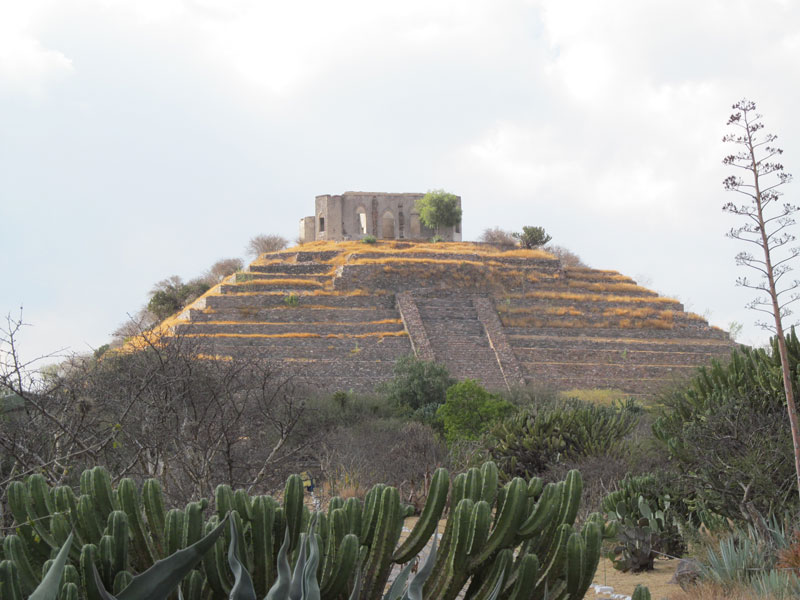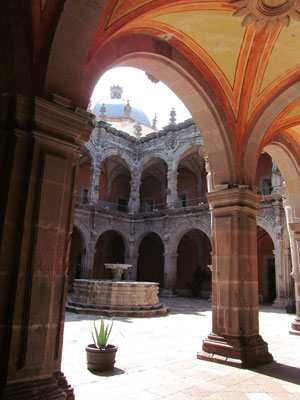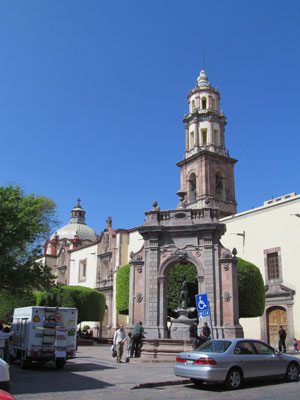Bajío region sites: El Cerrito
This item appears on page 53 of the January 2016 issue.
(Part 3 of 3 on central Mexico)
Querétaro is one of a trio of colonial cities that are the jewels of an area of central Mexico called the Bajío. Located north of Mexico City, these three cities — San Miguel de Allende, Guanajuato and Querétaro — were the focus of a lengthy visit to the Bajío that my husband, Paul, and I made in the winter of 2015. We rented a house in San Miguel for a month (Nov. ’15, pg. 54) and made multiday excursions to the other two cities.
With a population of about 625,000, Santiago de Querétaro (to give it its full proper name) is, by far, the largest of the three, although the city feels “small townish,” especially if you base yourself, as we did, in the compact historic center of the city.
Surprise archaeological site
We had not gone to Querétaro for archaeology, so “discovering” El Cerrito on our last afternoon there was serendipitous. It was our cab driver who asked us if we had yet visited the pyramid just outside the city. Despite advance research, we had no idea that Querétaro had its own pyramid, and we decided on the spur of the moment to see it for ourselves.
Located just a 20-minute drive from the historic center, El Cerrito (Little Hill) is anything but. The archaeological site is located in an area planted with huge cacti and from which you can see Querétaro in the distance.
Dominating the site, much of it still unexcavated, is an immense pyramid resting on an equally immense platform. Thirteen tiers rise almost 83 feet, with stairways on each of its four sides. Originally, this structure was covered with stucco and was painted in shades of red and blue. It must have been quite a striking sight as visitors approached.
Built probably between AD 700 and 900 (although there is some debate that it could have been constructed as early as AD 300) and more or less contemporaneous with Teotihuacán farther south, this pyramid was subsequently decorated in Toltec style in the years between 900 and 1200, when the Toltecs from Tula may have occupied the site.
The staircases on the four sides were added by yet another Mesoamerican group, the Chichimecs, who lived there from about 1200 until the arrival of the Spaniards in the 16th century.
Hacienda on pyramid top
The temple that once crowned the pyramid was probably destroyed by the owner of the property when he built a hacienda in 1887 atop the earth hill that covered the pyramid at the time.
This building, called El Fortín (Little Fort), is still on top of the pyramid and has, itself, become a historic property because it is more than 100 years old and also is considered a good example of 19th-century Bajío architecture.
Adjacent to the pyramid is the large rectangular Plaza of the Sculptures, a sunken patio enclosed by platforms on three sides. On these platforms there were columned rooms covered with roofs. These rooms contained altars where priests performed ceremonies.
Steps away, overlooking the Plaza of the Sculptures, is a long portico once supported by columns, whose bases remain. Altars were also found there with braziers in front of them. Some of the braziers still held the remnants of burnt offerings.
El Cerrito is not one of the major archaeological sites in Mexico. It’s not even one of the main archaeological sites in the Bajío (Nov. ’15, pg. 53 & Dec. ’15, pg. 53), but, to us, it was unexpected and therefore a “gift” we hadn’t counted on. It would be a mistake to miss seeing it if visiting Querétaro.
What else to see in Querétaro
We spent three nights in Querétaro, the minimum for any visitor, we feel. The highlights (all easily accessible by walking, if you’re staying in the historic center) include the 18th-century Plaza de Armas, surrounded by arcades and cafés; the peaceful Jardín Zenea, with a bandstand in the center and the Church of San Francisco across the street; the Museo Regional de Querétaro-INAH in the former monastery adjoining the Church of San Francisco, housing a small collection of pre-Columbian artifacts, including some from El Cerrito; the Museo de Arte de Querétaro in the former Augustinian monastery, with a fabulous Baroque courtyard dominated by gargoyles; the extraordinary Church of Santa Clara, considered one of Mexico’s finest Baroque buildings (the Baroque altars inside are “over the top”); the stupendous, 18th-century aqueduct that is one of the first sights visitors see when arriving in Querétaro, and, of course, El Cerrito, four miles outside the city.
If you can, you should try to squeeze in the two neighboring towns of San Sebastián Bernal, where one of the world’s largest monoliths is located, and Tequisquiapan, where you can do a tasting of sparkling wine at the Freixenet Wine Bar, just off the main square, Plaza Miguel Hidalgo. Each town is about an hour’s drive from Querétaro.
If you go…
We visited Querétaro from San Miguel de Allende, about a one-hour drive away. At a cost of $40 each way, we hired a car and driver to take us to Querétaro and pick us up three days later.
In Querétaro we stayed at the historic La Casa de la Marquesa (Madero 41, Colonia Centro, Querétaro, Qro, C.P. 76000, México; phone 011 52 442 227 0500, www.hotelcasadelamarquesa.com [in Spanish only], a colonial-era mansion now a fabulous hotel where tourists go to gawk at the Moorish-inspired lobby.
No cookie-cutter rooms here. Each is unique. We rented the Colón suite, which cost $127 per night and came with a large terrace, overlooking many of Querétaro’s churches, as well as with an outdoor hot tub.
To get to El Cerrito from La Casa de la Marquesa, a cab charged us a flat $25 to take us there and back, with an hour to visit the site. El Cerrito is open from 9 to 3, Tuesday to Friday, and 9 to 5, Saturday and Sunday.



